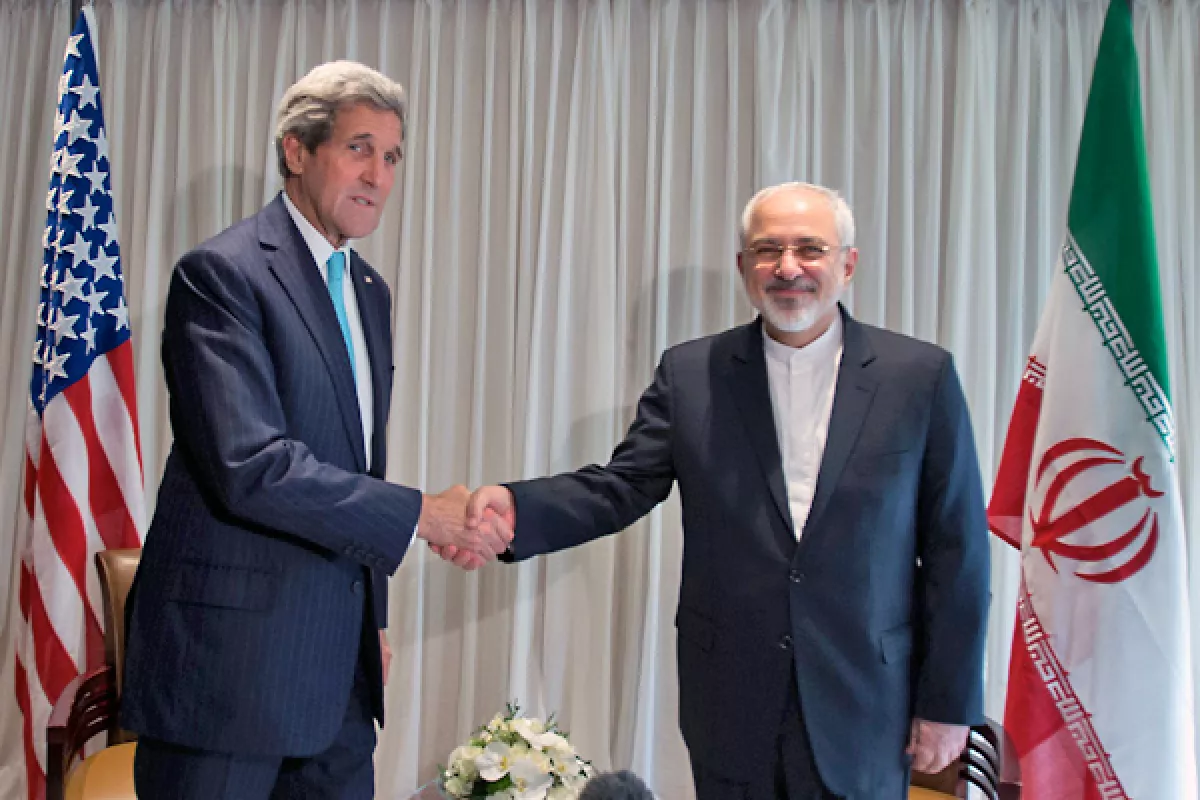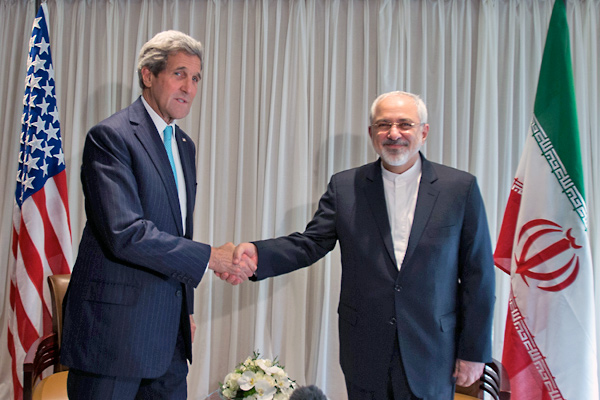Iran: the complicated and uncertain prospect of economic sanctions relief explained

Legal specialist on international trade and compliance Eric Lorber analyses the obstacles to successfully lifting, and if needs be, re-imposing sanctions against Iran, and sets out the timeline of sanctions relief following the nuclear agreement.

US Secretary of State John Kerry and Iran's Minister of Foreign Affairs Mohammad Javad Zarif. Photo: US Mission | Eric Bridiers
Following the landmark agreement between the P5+1 and Iran over its nuclear programme on 14 July 2015, attention has shifted to the details of the deal, and in particular how the United States, the European Union, and the United Nations Security Council (UNSC) will lift economic sanctions on the Islamic Republic in exchange for its fulfillment of its obligations under the Joint Comprehensive Plan of Action (JCPOA). Yet many obstacles remain to the successful unwinding of these sanctions – and to their re-imposition – should Iran fail to comply with the deal.
Obstacles to the successful lifting of sanctions
While many are optimistic that the agreement signifies the start of better relations between Iran and the West, much of the real work on ensuring a successful deal with Iran will come after the ink is dry. In the medium and long term, there are plenty of obstacles that could significantly undermine the sustainability of such an agreement.
"And while it seems unlikely that two-thirds of Congress would be willing to sink the agreement, the President will face a battle to ensure that members of the Democratic Party do not vote against it."
First – and most notably – the United States Congress will have the opportunity to weigh in on the deal and could scuttle it before it comes into legal effect. Congress has until 17 September to approve, stay silent, or disapprove of the deal. If a majority of both houses of Congress disapprove, President Obama can veto the resolution of disapproval and – unless Congress can override that veto with a two-thirds majority – the deal will be approved from the US side. And while it seems unlikely that two-thirds of Congress would be willing to sink the agreement, the President will face a battle to ensure that members of the Democratic Party do not vote against it.
The second major obstacle to the successful lifting of the sanctions will be Iranian compliance with the agreement. Given Iran’s long history of secrecy surrounding its nuclear programme, it is likely that there will be significant on-the-ground fights in Iran about what the terms of the deal actually are and how much information and access Iran must provide. If the US or other P5+1 countries believe that Iran is not fulfilling its obligations, those countries could use the ‘snapback’ mechanism described below to reverse sanctions relief.
"If the US or other P5+1 countries believe that Iran is not fulfilling its obligations, those countries could use the ‘snapback’ mechanism described below to reverse sanctions relief."
Third, while not an obstacle to legally lifting economic sanctions on the country, one significant impediment to the unwinding of sanctions is the continued implementation of an extensive web of non-nuclear sanctions. Western countries have made it clear that they will continue to pursue aggressive enforcement actions against companies that violate remaining sanctions on Iran related to its support for international terrorism and human rights abuses. This aggressive enforcement could deter significant investment in Iran, and the Islamic Republic could easily see these actions as reneging on the spirit – if not the letter – of the agreement.
Obstacles to the successful re-imposition of sanctions
Significant obstacles also exist to successfully re-imposing the sanctions should Iran be considered in violation of its obligations.
Under United Nations Security Council Resolution (UNSCR) 2231, adopted unanimously on 20 July 2015, if a JCPOA participant state believes that Iran has not performed its commitments, it can bring the issue before the Security Council and require Iran to resolve the matter. If the alleging state declares itself unsatisfied with the Iranian response, the Security Council will then vote on a draft resolution – ostensibly governed by typical Security Council voting procedures – to continue the termination/suspension of UN sanctions. If a country vetoes that resolution, as might happen if the alleging state happened to be a veto-player like the United States, the UN sanctions will be reinstated.
This means that the US by itself, even without the concurrence of the International Atomic Energy Agency (IAEA), can trigger the re-establishment of the legal basis for sanctions on Iran if it believes Iran has cheated on the agreement.
Snapping back sanctions like this would come at a great cost: Iran has declared that doing so absolves it of all its obligations in the agreement, and the UNSCR does not rebut Iran’s understanding. So the so-called “snapback” mechanism is powerful, but comes with a potent poison pill. In practice, what this means is that there will likely be a very high hurdle for determining that Iran is not complying with its obligations, a hurdle that will be tantamount to having to create a new coalition to impose sanctions.
Though the timeline of sanctions relief may be uncertain, one thing is clear: the hard work required to successfully implement the agreement, lift sanctions, and ensure that Iran remains in compliance with its obligations has just begun.
Timeline of sanctions relief 2015 to 2025
The JCPOA establishes a fairly specific timeline for sanctions relief that is generally cued to Iran’s fulfilment of its obligations under the deal.
Finalisation Day (14 July 2015) – the day the agreement was reached.
United Nations Security Council endorses the JCPOA (20 July 2015) – votes to terminate all prior UN sanctions, beginning on Implementation Day.
President Obama submits the agreement to the United States Congress, and the 60-day Congressional review period begins (20 July 2015-17 September 2015). During this review period, President Obama cannot lift sanctions. Congress can pass a resolution preventing the United States from agreeing to the deal, which the President would veto, and then Congress would vote again on the agreement.
Adoption Day (Approximately 20 October 2015) – 90 days after the UNSC endorses the JCPOA, or earlier based on a date agreed by JCPOA participants.
On this date, the JCPOA and its commitments come into effect. Participants will begin making the necessary preparations to implement their commitments under the agreement.
Implementation Day (likely early 2016) – when the International Atomic Energy Agency verifies that Iran has taken a number of steps under the agreement related to its nuclear programme.
Simultaneously, the EU will terminate certain Council Regulations that impose sanctions on Iran’s financial, banking, oil, petroleum, transport, and insurance sectors, as well as lifting sanctions on certain individuals.
The US will also cease the application of many so-called “secondary sanctions”. i.e., those sanctions that prevent non-US persons from conducting transactions with Iran and Iranian persons. These sanctions target Iran’s financial and banking sectors, as well as its oil and petrochemical industries.
The majority of US sanctions preventing US persons from conducting transactions in Iran will remain in place, though foreign subsidiaries of US persons may be permitted to engage in certain transactions, and US companies will be able to sell commercial passenger aircraft to Iran.
The United Nations Security Council will also terminate Security Council Resolutions 1696, 1737, 1747, 1803, 1835, 1929 and 2224, subject to their re-imposition in the event of significant non-performance by Iran of its JCPOA commitments.
5 Years after Adoption Day (October 2020) – UN sanctions preventing the sale of conventional arms to Iran are lifted.
Transition Day (October 2023) – UN sanctions on ballistic missiles are lifted. Iran must seek ratification of the Additional Protocol on Nuclear Safeguards (which it signed in 2003 but has not formally concluded).
The EU will lift sanctions targeting the assets of certain individuals involved in nuclear or ballistic missile activities, requiring the inspection of cargo travelling to and from Iran, and prohibiting the sale or transfer or financing of certain nuclear-related materials, among others.
The US will seek legislative action that would completely terminate those sanctions suspended since Implementation Day, sanctions on the acquisition of nuclear-related commodities and services, and would remove certain individuals and entities from US sanctions lists.
Termination Day (October 2025) – The United Nations Security Council Resolution (2231) endorsing the JCPOA terminates, as does all Security Council consideration of the Iranian nuclear programme.
The EU terminates all remaining sanctions.
Iran’s obligations to keep its enrichment capacity below a certain level terminate.
Eric Lorber is an associate at Gibson, Dunn & Crutcher LLP, where he practises in the firm's International Trade and Compliance practice group.
